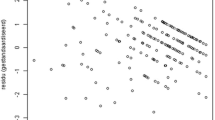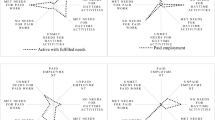Abstract
Background
Wing and Brown [Wing JK and Brown GW (1970) Institutionalism and schizophrenia: a comparative study of three mental health hospitals 1960–1968. Cambridge University Press, London] demonstrated a clear relationship between activity and clinical improvement, using time budget methodology with people with psychosis. However, existing time budget measures are demanding to complete, and simpler, check-box measures of activity rely on subjective frequency judgements and do not include the full range of activities in which an individual might be involved. We report on a pilot validation of a simplified time budget measure of activity levels for routine use as a measure of change with people with psychosis.
Methods
Forty-two participants living in the local community with a schizophrenia spectrum diagnosis were grouped according to length of illness and, within the longer duration group, into high/low activity. All completed the time budget. On a second occasion, 15 participants also completed the subscales of the Social Functioning Scale (SFS) (Br J Psychiatry 157:853–859, 1990) to assess construct validity, and 15 completed the time budget to assess test–retest reliability.
Results
The time budget discriminated between duration and activity level groups and showed good inter-rater reliability and test–retest reliability. On the SFS, correlations with subscales measuring withdrawal, activities of daily living and employment were found.
Conclusions
Results indicate that our measure is tapping the activity component of social functioning. A larger scale validation study and investigation of sensitivity to change is underway.
Similar content being viewed by others
References
American Psychiatric Association (APA) (1994) Diagnostic and statistical manual of mental disorders (DSM IV). Washington DC:APA
Barrowclough C, Tarrier N (1990) Social functioning in schizophrenic patients. I. The effects of expressed emotion and family intervention. Soc Psychiatry Psychiatr Epidemiol 25:125–129
Birchwood MJ, Smith J (1987) Schizophrenia and the family. In: Orford J (ed) Coping with disorder in the family. Croom-Helm, Beckenham
Birchwood M, Smith J, Cochrane R, Wetton S, Copestake S (1990) The Social Functioning Scale. The development and validation of a new scale of social adjustment for use in family intervention programmes with schizophrenic patients. Br J Psychiatry 157:853–859
Birchwood M, McGorry P, Jackson H (1997) Early intervention in schizophrenia. Br J Psychiatry 170:2–5
Breier A, Schreiber JL, Dyer J, Pickar D (1991) National Institute of Mental Health longitudinal study of chronic schizophrenia. Prognosis and predictors of outcome. Arch Gen Psychiatry 48:239–246
Gumley A, O'Grady M, McNay L, Reilly J, Power K, Norrie J (2003) Early intervention for relapse in schizophrenia: results of a 12-month randomized controlled trial of cognitive behavioural therapy. Psychol Med 33:419–431
Hayes RL, Halford WK (1996) Time use of unemployed and employed single male schizophrenia subjects. Schizophr Bull 22:659–669
Jolley S, Garety P, Craig T, Dunn G, White J, Aitken M (2003) Cognitive therapy in early psychosis: a pilot randomized controlled trial. Behav Cogn Psychother 31:473–478
Katz N, Giladi N, Peretz C (1988) Cross-cultural application of occupational therapy assessments: human occupation with psychiatric outpatients and controls in Israel. Occup Ther Ment Health 8:7–30
Olbrich R, Voss E, Mussgay L, Pfeiffer H (1993) A weighted time budget approach for the assessment of cognitive and social activities. Soc Psychiatry Psychiatr Epidemiol 28:184–188
Purvis RG, Ohlsen RI, O'Toole MS, Pilowsky LS, Brown RG (2004) Real-world functional outcome in schizophrenia: a goal-directed behaviour model. Schizophr Res 62 1S:200
Weissman MM (1975) The assessment of social adjustment. A review of techniques. Arch Gen Psychiatry 32:357–365
Weissman MM, Sholomskas D, John K (1981) The assessment of social adjustment. An update. Arch Gen Psychiatry 38:1250–1258
Wing JK and Brown GW (1970) Institutionalism and schizophrenia: a comparative study of three mental health hospitals 1960–1968. Cambridge University Press, London
Author information
Authors and Affiliations
Corresponding author
Appendix
Appendix
Time budget full scoring criteria and measure
-
0
Nothing—lying thinking, sleeping, sitting etc.
-
1
Predominantly passive activity. Watching TV, listening to radio, eating a meal prepared by someone else. Includes brief chatting with people who are already there (e.g. staff, group home or hostel), unless there is evidence that person actively sought out and engaged in company and conversation (see 2). Taking care of basic hygiene
-
2
An independent activity requiring some planning and motivation, but relatively simple or brief, e.g. a walk to the local shops to get cigarettes, tidying room, washing-up, preparing a simple meal for oneself. Attending a group in a hostel. Accompanied group outing from a hostel. Social contact that does not require much planning, e.g. seeking out and talking to friend in a hostel; being visited, without any specific activity or preparation. Talking to people sitting with during lunch (if not in hostel or group home). Reading (e.g. browsing through the paper or a magazine, flicking through a book or a brief period of involved reading). A phone call to someone
-
3
Several 2-rated activities completely filling a time period, sounding ‘busy’ (e.g. got breakfast, washed up, got newspapers from shop, looked at papers, made coffee, got cigarettes from shop, tidied up, listened to music and chatted with friend in hostel, went out for milk for staff) or a more complex and demanding but unvaried or shorter activity. Examples: visiting somebody when this requires a journey but a limited range of activities—e.g. ‘went to Mum's on bus’, e.g. ‘played computer bridge all morning’. Attending a day centre or rehabilitation centre. A trip out which takes time but may not be very demanding—e.g. ‘went to church’ for whole time period, e.g.‘went to pub with friend’, e.g. preparing a complicated meal for self. Reading if lengthy and obviously goal directed (e.g. read a novel, or read something for course of study)
-
4
Time period filled with a variety of demanding independent activities requiring significant motivation and planning and with some variation in tasks, e.g. work, a course of study, a trip out requiring organisation—meeting people, transport, varied activities, e.g. ‘met friend went round shopping centre shopping together, went for lunch together’; e.g. ‘took tube into central London, went to museum, tea at café, walked around park’; e.g. ‘met friends, went to pub, went on to club, talking and dancing’
Rights and permissions
About this article
Cite this article
Jolley, S., Garety, P., Dunn, G. et al. A pilot validation study of a new measure of activity in psychosis. Soc Psychiat Epidemiol 40, 905–911 (2005). https://doi.org/10.1007/s00127-005-0982-x
Accepted:
Published:
Issue Date:
DOI: https://doi.org/10.1007/s00127-005-0982-x




